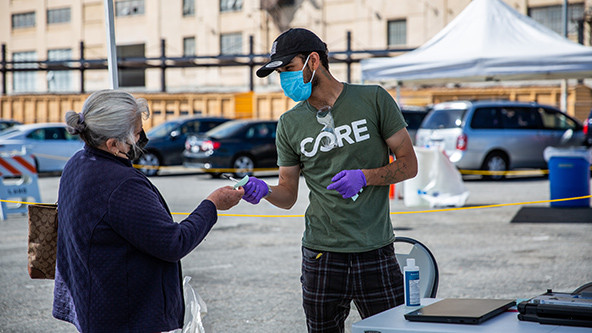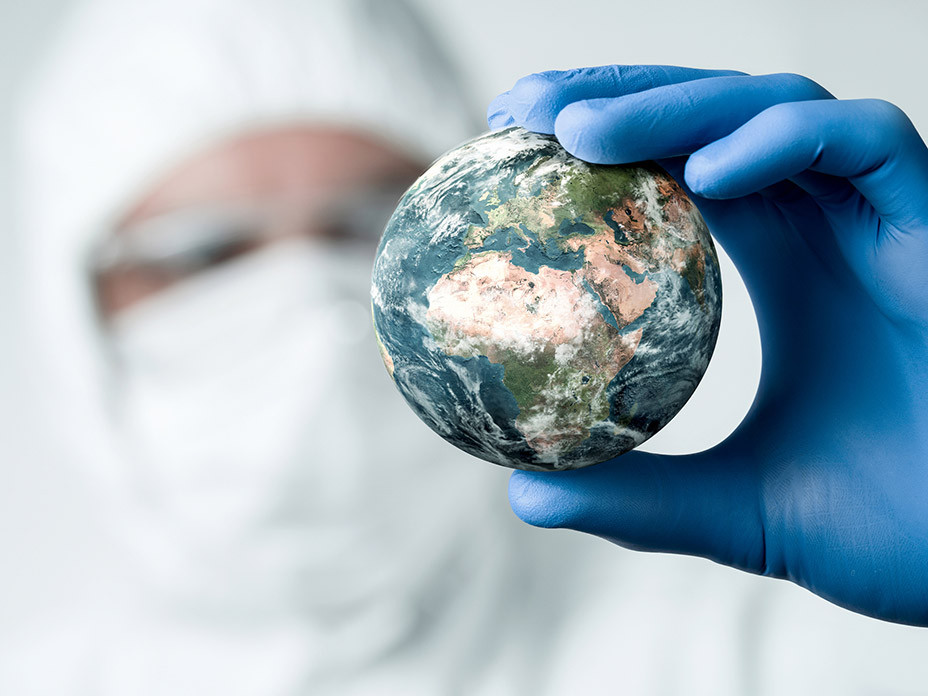 A mobile vaccination site in the Boyle Heights neighborhood of Los Angeles in February 2021. (Photo courtesy of CORE)
A mobile vaccination site in the Boyle Heights neighborhood of Los Angeles in February 2021. (Photo courtesy of CORE)
More than 153 million people in the United States are fully vaccinated against COVID-19. While this is laudable progress, much work remains to be done to ensure every American gets equitable access to this vital resources. Research from the Kaiser Family Foundation shows the extent of the disparity: Across 41 states, 44 percent of white people have gotten at least one dose, while only 31 percent of Black people and 35 percent of Hispanic people can say the same as of early June.
Attributing these disproportionate rates to "vaccine hesitancy," as many commentators have done, sidesteps a confrontation the country must have with the barriers to vaccine access among communities of color and people living in low-income and rural areas.

If we close the gaps that have created such stark health disparities, we can end the pandemic, fully reopen the economy, and allow the country to rebuild on an even stronger, more equitable foundation. Community-based organizations—groups that have established long-term relationships with their neighbors and solidified their trust during the pandemic—are essential to achieving these goals.
Our organizations, CORE and Partners In Health (PIH), have worked with community-based organizations, governments, and others on equity-focused vaccination operations in the United States and around the globe. We published a free manual with our insights into the process. As governments and community-based organizations continue to roll out vaccinations, we recommend they account for five strategic concerns to ensure they help marginalized and underserved individuals: geography, partnerships, language, schedules, and technology.
Geography
Gaps in vaccine access often occur due to a combination of transportation challenges and the distance between health care sites and where people live and work.
The first step to solving this problem is understanding exactly where it occurs. In Ohio, PIH works with community, government, and academic partners to identify where gaps exist by mapping the relationship between vaccination coverage and public transportation options. This makes it clear where mobile vaccination units should be deployed.
CORE uses mobile units, as well as walk-up and drive-through sites, to make it easier to get vaccines to where marginalized community members already are rather than leaving them with the challenges of going to a distant or unfamiliar location. In Los Angeles, more than 90 percent of vaccine doses at CORE’s mobile sites—run in collaboration with the city's fire department, the mayor’s office, and other divisions—have gone to people of color.
Partnerships
Community partners and local leaders play a vital role in bridging the gap between the marginalized people who need a vaccine and the medical system that can provide it. CORE and PIH work with trusted and familiar local messengers––such as doctors, nurses, faith leaders, and community health workers––to help people overcome any fear and skepticism they may have about the vaccine. Both CORE and PIH prioritize hiring staff directly from the communities we serve, which not only supplies first-hand knowledge about local affairs but also provides jobs during a time of economic uncertainty. PIH and its partners hired and trained more than 5,900 contact tracers, case investigators, and community health workers from local communities to support the COVID-19 response. CORE has provided nearly 4,000 community members with employment throughout the pandemic.
CORE and PIH work in close partnership with local government and public health departments to make sure we successfully navigate any bureaucratic or political issues that could prevent the delivery of vaccines. They're also important when it comes to dividing the labor. We found that local health departments are the best at logistical activities, such as getting shots into arms or administering tests. But when it comes to setting up and scaling operations, emergency agencies—such as first responders and public safety officials—are best equipped due their operational infrastructure and experience with frontline work.
In Los Angeles, CORE worked with city officials, the fire department, and others to turn Dodger Stadium into the nation’s largest mass vaccination site at the onset of 2021. CORE also brought in the biotech company Carbon Health to help the city streamline appointment registration and manage early fluctuations in the supply of vaccines.
In Chicago, PIH and a consortium of more than 135 community, government, and health care organizations––known as the Chicagoland Vaccine Partnership––empowered local leaders with resources to help them engage their friends and neighbors about vaccination. Through virtual town halls, staff trainings, and other events—even an online baking class—these local leaders shared information with their communities to address concerns about vaccines and help overcome barriers to access.
Language
If information on vaccines is not simple, culturally relevant, and translated into the languages spoken in each community, it simply won't reach the people who need to hear it, and doses won't get delivered.
In Immokalee, Florida, where just 12 percent of residents speak English at home, PIH and our partners hired community members who were fluent in local languages. These health promoters or "promotoras"—trusted neighbors who could use their relationships to alleviate fears in a health system with a long history of inequity—went door-to-door to share crucial information on COVID-19 and vaccines. When people showed up for their vaccine appointments, the translation help didn't stop. Spanish, Creole, and English speakers accompanied vaccine seekers through every step, and signage and other educational materials were available in all of the local languages.
CORE's "It’s Time Los Angeles" marketing campaign is another example; it reaches out to communities of color across the city in five languages. And CORE’s team in Georgia was structured to reach a wide array of people, pulling together a diverse staff that collectively speaks 22 languages and includes many refugees.
Schedules
People seeking vaccines may not have the luxury of being able to do it at a time most convenient to a health care provider. They may be locked into work demands during the day. They may be unable to schedule an appointment due to a variety of barriers, and so need to show up whenever an opportunity presents itself.
If vaccine providers aren't flexible with when they offer the doses, they may never connect with the people who need them. This problem became clear when residents from neighboring Naples and Fort Myers flooded the local health department's first vaccination event held in Immokalee, Florida. In response, city officials worked with PIH, Healthcare Network (HCN), the Coalition of Immokalee Workers (CIW), and others to develop a more accessible appointment-based system. The previously described health promoters worked with the community to create a list of people interested in receiving a vaccine, called them to make the appointments, and even offered transportation to the sites. The group also organized no-appointment-required vaccination events at more convenient times that were within easy-to-reach locations across Immokalee. The efforts worked: More than 10,000 shots have been administered to residents through HCN- and CIW-supported events in Immokalee.
Increasing hours of operation at vaccination sites was also effective. In Los Angeles, CORE and our partners were able to reach a wider demographic by implementing 12-hour vaccination days, in some cases extending hours until 10 p.m.
Technology
Many organizations failed to pay sufficient attention to the information systems used in the rollout of vaccines. Complex scheduling, registration processes, and other technological issues led to frustration and discouragement among the people trying to sign up for vaccines and the people providing them. The shortcomings not only delayed the distribution of life-saving resources but also generated distrust among communities, particularly those that were already wary of government and health institutions.
While robust and easy-to-use software and hardware are integral to delivering vaccines, low-tech solutions must also be available to ensure those who lack digital literacy and access are not left behind.
To help people without access to a smartphone, computer, or the internet, CORE partners with telemedicine platforms to streamline data and registration systems and offer the vaccine on site at mobile units. For example, CORE partnered with Curogram to launch a statewide mobile vaccination program with the Georgia Department of Health, which has been instrumental in vaccinating patients from diverse communities throughout the state. In remote areas, such as mountainous regions of Puerto Rico, CORE’s team used paper registration on site that was followed by data input, which helped ensure real-time tracking of vaccine uptake while adapting to community circumstances.
In Massachusetts, PIH and the New Bedford Health Department supplemented online registration with paper forms. The health department also set up a call center, staffed with operators who collectively spoke numerous languages, to support residents who may have had access only to a phone or needed to speak a language other than English. If a vaccine was delivered in two stages, the health department employees would proactively reach out to set up a second appointment.
Act Now for Today's and Tomorrow's Crisis
As the struggle with COVID-19 continues, it’s crucial that governments and public health organizations in the United States remove barriers to vaccination access and center equity into every step of the process. They can start by examining how well they're performing in the five strategic areas we described above, which are explored in more detail in our guide. If they fail to do so, COVID-19 will continue to devastate some of the most vulnerable communities around the world, and an opportunity to make them even stronger for future crises will be wasted.
Support SSIR’s coverage of cross-sector solutions to global challenges.
Help us further the reach of innovative ideas. Donate today.
Read more stories by Ann Lee & Sheila Davis.

